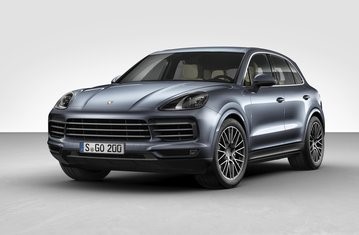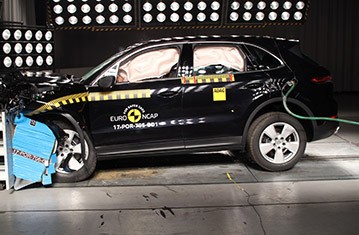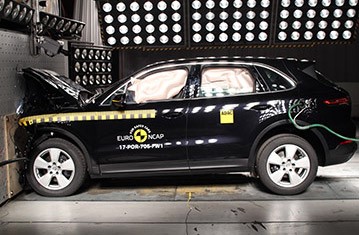- With standard equipment
- With safety pack
Find more information in the General Comments section of the assessment
Find more information in the Rating Validity tab of the assessment
- See More
- See More
- See More
- See More
- Good
- Adequate
- Marginal
- Weak
- Poor
 Passenger
Passenger
 Driver
Driver
 Rear Passenger
Rear Passenger
 Driver
Driver
 Car
Car
 Pole
Pole
 Rear Seat
Rear Seat
 Front Seat
Front Seat
- Good
- Adequate
- Marginal
- Weak
- Poor


Passenger
outboard
center
Fitted to the vehicle as standard
Not fitted to the test vehicle but available as option
Not Available
-
i-Size CRS
-
ISOFIX CRS
-
Universal Belted CRS
Easy
Difficult
Safety critical
Not allowed
| Seat Position | ||||
|---|---|---|---|---|
| Front | 2nd row | |||
| Passenger | Left | center | Right | |
| Maxi Cosi 2way Pearl & 2wayFix (rearward) (iSize) | ||||
| Maxi Cosi 2way Pearl & 2wayFix (forward) (iSize) | ||||
| BeSafe iZi Kid X2 i-Size (iSize) | ||||
| Maxi Cosi Cabriofix & FamilyFix (ISOFIX) | ||||
| BeSafe iZi Kid X4 ISOfix (ISOFIX) | ||||
| Britax Römer Duo Plus (ISOFIX) | ||||
| Britax Römer KidFix XP (ISOFIX) | ||||
| Maxi Cosi Cabriofix (Belt) | ||||
| Maxi Cosi Cabriofix & EasyBase2 (Belt) | ||||
| Britax Römer King II LS (Belt) | ||||
| Britax Römer KidFix XP (Belt) | ||||
Easy
Difficult
Safety critical
Not allowed
In the frontal offset test, protection of the neck of the 10 year dummy was rated as poor, based on dummy readings of tensile forces. In the 6 year dummy, readings of decelerations in the chest of the 6 year dummy led to protection of that body region being rated as marginal. The front passenger airbag can be disabled to allow a rearward-facing child restraint to be used in that seating position. Clear information is provided to the driver regarding the status of the airbag and the system was rewarded. All of the restraint types for which the Cayenne is designed could be properly installed and accommodated in the car.
- Good
- Adequate
- Marginal
- Weak
- Poor

Head Impact 19.2 Pts
Pelvis Impact 0.0 Pts
Leg Impact 6.0 Pts
| System Name | Porsche Active Safe | ||
| Type | Auto-Brake with Forward Collision Warning | ||
| Operational From | 5 km/h | ||
| Additional Information | Defaults on for every journey; operates above 40km/h and in low ambient light | ||
| PERFORMANCE | | |||
| Autobrake Function | |||
| Avoidance | Mitigation | ||
|
Running Adult crossing from Farside
|
Collision avoided up to 40 km/h | Impact mitigated up to 60 km/h | |
|
Walking Adult crossing from Nearside -25%
|
Collision avoided up to 35 km/h | Impact mitigated up to 60 km/h | |
|
Walking Adult crossing from Nearside -75%
|
Collision avoided up to 45 km/h | Impact mitigated up to 60 km/h | |
|
Running Child from behind parked vehicles
|
Collision avoided up to 35 km/h | Impact mitigated up to 50 km/h | |
The Cayenne has a deployable, 'active' bonnet. Sensors detect when a pedestrian has been struck and actuators lift the bonnet to provide greater clearance to the hard structures in the engine bay. Porsche demonstrated that the system worked robustly for different pedestrian statures and over a wide range of speeds. Accordingly, the system was tested in the deployed position and good or adequate results were recorded over almost the entire bonnet surface. The protection provided by the bumper to pedestrians' legs was good at all test locations and maximum points were scored. However, protection of the pelvis was poor at all test points. The autonomous emergency braking system performed well in tests of its pedestrian detection, with impacts mostly avoided or mitigated.
- Good
- Adequate
- Marginal
- Weak
- Poor
| System Name | Cruise control including speed limiter |
| Speed Limit Information Function | Map based |
| Warning Function | Active braking (no warning necessary) |
| Speed Limitation Function | Manually set (accurate to 5km/h) |
| Applies To | All seats | ||
| Warning | Driver Seat | Front Passenger(s) | Rear Passenger(s) |
| Visual | |||
| Audible | |||
|
|||
| System Name | Porsche Active Safe | |||
| Type | Forward Collision Warning with Auto-Brake | |||
| Operational From | 10 km/h | |||
| Additional Information | Default On; Supplementary Warning | |||
| Performance | | ||||
| Autobrake Function Only | Driver reacts to warning | |||
| Operational Speed | 10-250 km/h | 10-250 km/h | ||
| Approaching a stationary car | See AEB City | Crash avoided up to 40km/h.Crash speed reduced up to 70km/h. | ||
| Approaching a slower moving car | Crash avoided up to 70km/h. | Crash avoided up to 80km/h. | ||
| Following a car at short distance | ||||
| Car in front brakes gently | Avoidance | Avoidance | ||
| Car in front brakes harshly | Avoidance | Mitigation | ||
| Following a car at long distance | ||||
| Car in front brakes gently | Avoidance | Avoidance | ||
| Car in front brakes harshly | Avoidance | Avoidance | ||
The Cayenne has, as standard, a seatbelt reminder system for the front and rear seats. The speed assistance system recognises local speed limits and informs the driver, who can then set the limiter appropriately. Tests of the autonomous emergency braking system at highway speeds demonstrated good performance with most collisions avoided or mitigated. A lane assistance system is available as an option but is not included in this assessment.
- Specifications
- Safety Equipment
- Videos
- Rating Validity
Specifications
Tested Model Porsche Cayenne 3.0 diesel, LHD
Body Type - 5 door SUV
Year Of Publication 2017
Kerb Weight 2169kg
VIN From Which Rating Applies - all Cayennes
Class Large SUV
Safety Equipment
Note: Other equipment may be available on the vehicle but was not considered in the test year.
Fitted to the vehicle as standard
Fitted to the vehicle as part of the safety pack
Not fitted to the test vehicle but available as option or as part of the safety pack
Not available
Not applicable
Videos
Rating Validity
Variants of Model Range
| Body Type | Engine & Transmission | Model Name/Code | Drivetrain | Rating Applies | |
|---|---|---|---|---|---|
| LHD | RHD | ||||
| 5 door SUV | 3.0 diesel | Cayenne Diesel* | 4 x 4 |  |
 |
| 5 door SUV | 3.0 petrol | Cayenne | 4 x 4 |  |
 |
| 5 door SUV | 2.9 petrol | Cayenne S | 4 x 4 |  |
 |
| 5 door SUV | 4.0 petrol | Cayenne Turbo | 4 x 4 |  |
 |
* Tested variant





Find more information in the General Comments section of the assessment
 Share
Share










The passenger compartment of the Cayenne remained stable in the frontal offset test. Dummy readings indicated good protection of the knees and femurs of the driver and passenger. Porsche showed that a similar level of protection would be provided to occupants of different sizes and to those sat in different positions. In the full-width rigid barrier test, protection was good or adequate for all critical body regions of both dummies except the chest of the rear passenger, protection of which was rated as marginal based on readings of chest compression. In the side barrier test, protection of all critical body areas was good and the Cayenne scored maximum points. Even in the more severe side pole test, protection of the chest was adequate and that of other critical body areas was good. Tests on the front seats and head restraints demonstrated good protection against whiplash injury in the event of a rear-end collision. A geometric assessment of the rear seats also indicated good whiplash protection. The Cayenne has a standard-fit autonomous emergency braking system. Tests of its performance at the low speeds, typical of city driving, at which many whiplash injuries are caused revealed good performance, with impacts avoided at all test speeds.